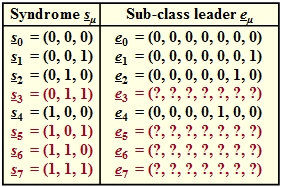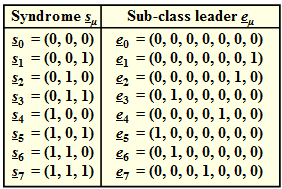Difference between revisions of "Aufgaben:Exercise 1.11: Syndrome Decoding"
| Line 121: | Line 121: | ||
| − | [[File: | + | [[File:EN_KC_A_1_11d_v2.png|right|frame|All coset leaders of the $HC (7, \, 4, \, 3)$ ]] |
'''(5)''' A comparison with the solution to the last subtask shows that $(0, 1, 0, 0, 0, 0, 0) \cdot \boldsymbol{\rm H}^{\rm T}$ as a syndrome gives the second row of the transposed matrix: | '''(5)''' A comparison with the solution to the last subtask shows that $(0, 1, 0, 0, 0, 0, 0) \cdot \boldsymbol{\rm H}^{\rm T}$ as a syndrome gives the second row of the transposed matrix: | ||
Revision as of 17:07, 20 April 2023
To decode a $(7, \, 4, \, 3)$ Hamming code, which is defined by its parity-check matrix
- $${ \boldsymbol{\rm H}}_{\rm } = \begin{pmatrix} 1 &1 &0 &1 &1 &0 &0\\ 0 &1 &1 &1 &0 &1 &0\\ 1 &0 &1 &1 &0 &0 &1 \end{pmatrix} \hspace{0.05cm},$$
"syndrome decoding" is also suitable. Since all Hamming codes are perfect, the result is as good as with the $($in the general case$)$ more complicated maximum likelihood decoding.
For "syndrome decoding" one proceeds as follows:
- From the received vector $\underline{y}$ one forms the syndrome $($it holds $m = n - k)$:
- $$\underline{s} = \underline{y} \cdot { \boldsymbol{\rm H}}^{\rm T} \in {\rm GF}(2^m) \hspace{0.05cm}.$$
- In "BSC channel" the received word $\underline{y} = \underline{x} \, ({\rm code\:word}) + \underline{e} \, ({\rm error\:vector})$ is also an element of ${\rm GF}(2^n)$, and it holds because of $ \underline{x} · \boldsymbol {{\rm H} }^{\rm T} = \underline{0}$:
- $$\underline{s} = \underline{e} \cdot { \boldsymbol{\rm H}}^{\rm T} \hspace{0.05cm}.$$
- Many error patterns $\underline{e}$ lead to the same syndrome $\underline{s}$. One now groups those error patterns with the same syndrome $\underline{s}_{\mu}$ to the coset ${\it \Psi}_{\mu}$.
- The coset leader $\underline{e}_{\mu}$ is the fault vector that has the lowest Hamming weight within the class ${\it \Psi}_{\mu}$ and is accordingly the most probable. If there are several of these, one chooses one of them arbitrarily.
The above graph shows the incomplete list of coset leaders $\underline{e}_{\mu}$ for each $\underline{s}_{\mu}$.
The most likely error vectors
- $\underline{e}_{3}$ with syndrome $\underline{s}_{3} = (0, 1, 1)$,
- $\underline{e}_{5}$ with syndrome $\underline{s}_{5} = (1, 0, 1)$,
- $\underline{e}_{6}$ with syndrome $\underline{s}_{6} = (1, 1, 0)$,
- $\underline{e}_{7}$ with syndrome $\underline{s}_{7} = (1, 1, 1)$
are to be determined in the subtasks (4) and (5).
Hints:
- This exercise belongs to the chapter "Decoding of Linear Block Codes".
- Underlying is a Hamming code with parameters $n = 7$, $k = 4$ ⇒ $m = 3$. All code words have the following format:
- $$\underline{x} = ( x_1, x_2, x_3, x_4, x_5, x_6, x_7) = ( u_1, u_2, u_3, u_4, p_1, p_2, p_{3}) \hspace{0.05cm}.$$
- The parity-check equations are illustrated on the information sheet for "Exercise 1.11Z" which considers the same constellation as in the present exercise.
- In the last subtask (6), use the BSC parameter $ \varepsilon = 0.1$.
Questions
Solution
- With $m = 3$ parity bits, there are $2^3 = 8$ distinct values for the syndrome,
- $$\underline{s} \hspace{0.05cm} \in \hspace{0.05cm} \{ \underline{s}_0, \underline{s}_1,\hspace{0.05cm} \text{...} \hspace{0.05cm} , \underline{s}_7\} = \{ \underline{s}_{\mu} \}\hspace{0.05cm}, \hspace{0.2cm} \mu = 0, \hspace{0.05cm} \text{...} \hspace{0.05cm} , 7 \hspace{0.05cm},$$
- and just as many "cosets".
- Since in the Hamming code, which is perfect, all error vectors belong to one of the eight cosets ${\it \Psi}_{\mu}$ and, moreover, the number of all vectors in all cosets is the same ("Why should it be different?" Is that enough proof for you?), we get:
- $$ N_0 = \frac{2^n}{2^m} = 2^k \hspace{0.15cm} \underline{= 16} \hspace{0.05cm}.$$
- The cosets ${\it \Psi}_{0}$ include for example - see sample solution to "Exercise 1.11Z" - the vectors
- $$\underline{e} = (1, 1, 0, 0, 0, 0, 1),$$
- $$\underline{e} = (1, 1, 1, 1, 1, 1, 1).$$
(2) According to the comments of the last partial result, the following applies equally: $N_{7} \ \underline{= 16}$.
(3) Correct is answer 3:
- The coset leader $\underline{e}_{\mu}$ is the error vector $\underline{e}$ with the lowest "Hamming weight" $w_{\rm H}(\underline{e})$ that leads to the syndrome $\underline{s}_{\mu}$.
- The (7, 4, 3) Hamming code considered here is perfect. That is, all eight coset leaders therefore contain.
- either no "one" $(\underline{e}_{0}$ ⇒ no correction is required$)$, or
- exactly a single "one" $(\underline{e}_{1}, \hspace{0.05cm} \text{...} \hspace{0.05cm} , \underline{e}_{7}$ ⇒ an information or parity bit must be corrected$)$.
(4) It holds $\underline{s} = \underline{e} · \boldsymbol{\rm H}^{\rm T}$:
- $$\underline{s} = \begin{pmatrix} 1 &0 &0 &0 &0 &0 &0 \end{pmatrix} \cdot \begin{pmatrix} 1 &0 &1\\ 1 &1 &0\\ 0 &1 &1\\ 1 &1 &1\\ 1 &0 &0\\ 0 &1 &0\\ 0 &0 &1 \end{pmatrix} = \begin{pmatrix} 1 &0 &1 \end{pmatrix} = \underline{s}_5 \hspace{0.3cm} \Rightarrow\hspace{0.3cm} \hspace{0.15cm} \underline{ \mu= 5} \hspace{0.05cm}.$$
(5) A comparison with the solution to the last subtask shows that $(0, 1, 0, 0, 0, 0, 0) \cdot \boldsymbol{\rm H}^{\rm T}$ as a syndrome gives the second row of the transposed matrix:
- $$\begin{pmatrix} 0 &1 &0 &0 &0 \hspace{0.2cm}\text{... }\end{pmatrix} \cdot { \boldsymbol{\rm H}}^{\rm T} = \begin{pmatrix} 1 &1 &0 \end{pmatrix} = \underline{s}_6$$
- $$\Rightarrow\hspace{0.45cm} \underline{ \mu= 6} \hspace{0.05cm}, \hspace{0.5cm} \underline{e}_6 = \begin{pmatrix} 0 &1 &0 &0 &0 &0 &0 \end{pmatrix}\hspace{0.05cm}.$$
- $$\begin{pmatrix} 0 &0 &1 &0 &0 \hspace{0.2cm}\text{... }\end{pmatrix} \cdot { \boldsymbol{\rm H}}^{\rm T} = \begin{pmatrix} 0 &1 &1 \end{pmatrix} = \underline{s}_3$$
- $$\Rightarrow\hspace{0.45cm} \underline{ \mu= 3} \hspace{0.05cm}, \hspace{0.5cm} \underline{e}_3 = \begin{pmatrix} 0 &0 &1 &0 &0 &0 &0 \end{pmatrix}\hspace{0.05cm}.$$
- $$\begin{pmatrix} 0 &0 &0 &1 &0 \hspace{0.2cm}\text{... } \end{pmatrix} \cdot { \boldsymbol{\rm H}}^{\rm T} = \begin{pmatrix} 1 &1 &1 \end{pmatrix} = \underline{s}_7$$
- $$\Rightarrow\hspace{0.45cm} \underline{ \mu= 7} \hspace{0.05cm}, \hspace{0.5cm} \underline{e}_7 = \begin{pmatrix} 0 &0 &0 &1 &0 &0 &0 \end{pmatrix}\hspace{0.05cm}.$$
The adjacent graph summarizes again the results of the subtasks (4) and (5).
(6) For the $(7, \, 4, \, 3)$ Hamming code under consideration, the correct information word is decided if at most one bit within the code word is falsified during transmission. It follows:
- $${ \rm Pr(block\:errors)} \hspace{-0.15cm}\ = \ \hspace{-0.15cm} { \rm Pr(\ge 2\hspace{0.15cm}bit\hspace{0.15cm}errors\hspace{0.15cm})} =1 - { \rm Pr(0\hspace{0.15cm}bit\hspace{0.15cm}errors)} - { \rm Pr(1\hspace{0.15cm}bit\hspace{0.15cm}errors)} =1 - 0.9^7 - 7 \cdot 0.1 \cdot 0.9^7 \hspace{0.15cm} \underline{ = 0.15} \hspace{0.05cm}.$$
- Uncoded transmission of a block with $n = k = 4$ bits would result in the same BSC channel:
- $${ \rm Pr(block\:errors)}= 1 - 0.9^4 \approx 0.344 \hspace{0.05cm}.$$
- The comparison is not entirely fair, however, since with $n = 4$ a smaller falsification probability $\varepsilon$ would have to be applied than with $n = 7$ $($smaller symbol rate ⇒ smaller bandwidth ⇒ smaller noise power$)$.

